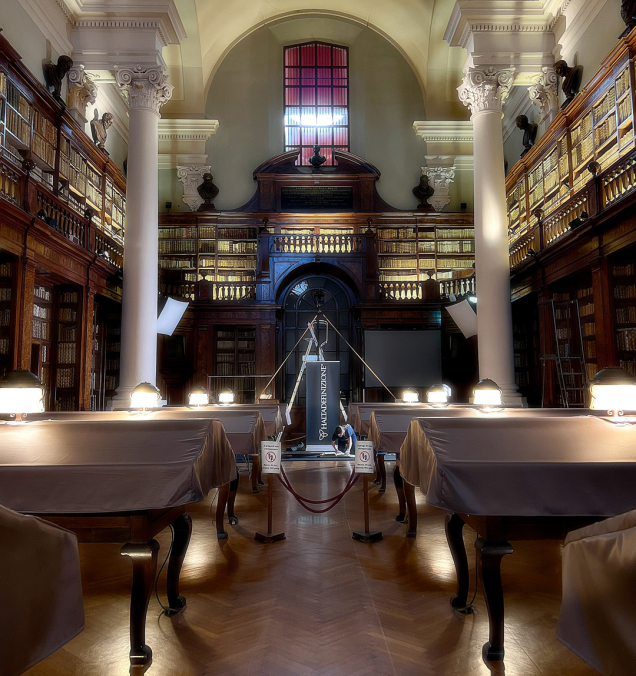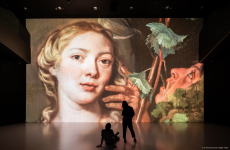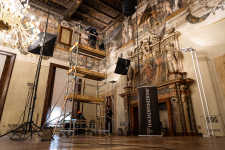On Friday, February 17, 2023, the University Library of Bologna presents the exhibition Traces of Armenia in the Atrium of the Great Hall, as part of the international congress "Armenia un popolo plurimillenario" (The plurimillennial history of the Armenian people) promoted by the Alma Mater Studiorum of Bologna. For the occasion, the digital image made by Haltadefinizione of the "Armenian Map" of Count Luigi Ferdinando Marsili (Constantinople, 1691) will be projected in gigapixel resolution.
Scroll 24 of the Marsili Archive, annotated on the back as “Tabula Chorographica Armenica” is an extraordinary map of the Armenian Church. It was discovered in 1991 in the Library during the preparatory work for the exhibition of maps entitled "Explorations in the Library." The map is made of 16 sheets of paper glued to canvas. It is quite large, at 11 feet and 9 inches wide and almost 4 feet high (358 x 120 cm). It is dotted with colorful watercolor drawings and captions in Armenian that describe hundreds of monasteries, churches, hermitages, shrines and places of worship, divided into the four districts or ‘catholicosates’ that existed at the time it was made.
In the BUB Digital Library you can examine the extraordinary clarity and detail of the front and back of the Haltadefinizione digitized map.
In addition to the monumental Armenian map, a selection of valuable documents and scrolls belonging to the Marsili Archive has been digitized. The technology of photo stitching with scanning to a field-placed Nodal Point allows for digitization of large and small formats with a level of detail that can exceed 1000 pixels per inch.
Depending on the size of the documents to be acquired digitally, any number from tens to hundreds of individual photographs are taken. They are then united using a stitching algorithm which produces an image of extraordinarily high definition. This work is done under a strict procedures for the protection of the works being photographed.
Haltadefinizione completed the digitization of the large and very large formats of the Marsili Archive of the University Library of Bologna as part of the "The Luigi Ferdinando Marsili Museum," project, co-financed by the Carisbo Foundation.
The exhibition
The University Library of Bologna, like other historical libraries of Italy, has many ancient documents in the Armenian language both manuscripts and prints, which demonstrates the well-established cultural relations between Italy and the Armenian people since the Early Middle Ages. In addition to the "Armenian Map of Count Marsili" (Constantinople, 1691), visible through the high-resolution images recently acquired by the Library, the exhibition offers its visitors some of the most significant pieces of the collection. Three illuminated manuscripts and nine printed volumes stand out, each of which represents a particular moment in Italian-Armenian relations or, more generally, of the contacts between the Armenians, Italy and Europe through printing.
The most exceptional piece is the "Armenian Map" of the Bolognese Count Luigi Ferdinando Marsili (BUB, rot. 24) which he commissioned in Constantinople in 1691. It unexpectedly emerged from the library deposits exactly three centuries later.
To represent the ancient Armenian art of the artisinal manuscript book, three magnificent illuminated codexes (ms. numbers 3290, 3291 and 3292) were chosen. These were donated to the "Bolognese Pope" Benedict XIV by the first Armenian Catholic patriarch, Abraham Petros Ardzivian, when he came to Rome in 1742 for his ordination. Among the three manuscripts, the small Gospel (ms. 3290) stands out. It is a masterpiece both for the beautiful precious metal binding that protects it and for the rich and accurate series of miniatures (full-page and marginal) that adorn the pages, some of which are in gold.
The selection of ancient printed Armenian books, from the many owned by the University Library, includes nine volumes, some of which are particularly rare and valuable. The oldest book selected is "Oskan’s Bible" the first printed Armenian Bible, made in Amsterdam in 1666. There are only six of these luxury editions in the world and the BUB has one of them. Displayed next to it are the two copies owned by the BUB of the "Bible of Mechitar", printed in Venice between 1733-1735 by Abbot Mechitar (1676-1749), founder of the order of the Mechitarist Fathers of the Island of S. Lazzaro in Venice, of which one particularly valuable (A.M.O.V.1). There follow other volumes printed both by Armeni and by other Italian and foreign persons or institutions, for missionary use or to study the Armenian language and civilization.
Finally, the last two volumes on display represent the extraordinary cultural activity promoted through the press by the Mechitarist monks of San Lazzaro Island in Venice. First, the History of the Armenians of Father Mikʿayēl Čʿamčʿean, published in three volumes (Venice, 1784-1786), offers the first reconstruction of Armenian history in a modern scientific sense. The other is the Armenian Paralipomena of Filone Alessandrino (First Century BCE to First Century CE), published by Father Giovan Battista Aucher (Venice 1826). The latter, as well as the previous editions published by the Mechitarist Fathers in the early nineteenth century of works of Greek literature preserved only in their ancient Armenian translation, were at the center of great interest by Italian and European scholars, including Giacomo Leopardi.



